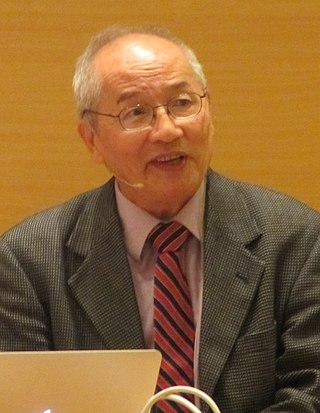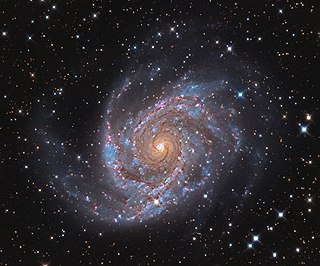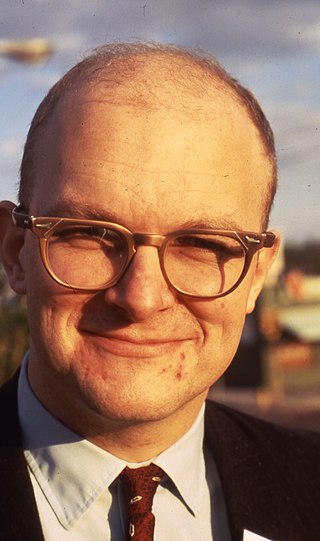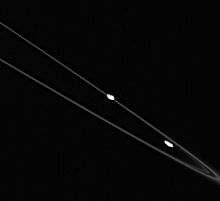
Donald Lynden-Bell CBE FRS was a British theoretical astrophysicist. He was the first to determine that galaxies contain supermassive black holes at their centres, and that such black holes power quasars. Lynden-Bell was President of the Royal Astronomical Society (1985–1987) and received numerous awards for his work, including the inaugural Kavli Prize for Astrophysics. He worked at the University of Cambridge for his entire career, where he was the first director of its Institute of Astronomy.

John Norris Bahcall was an American astrophysicist and the Richard Black Professor for Astrophysics at the Institute for Advanced Study. He was known for a wide range of contributions to solar, galactic and extragalactic astrophysics, including the solar neutrino problem, the development of the Hubble Space Telescope and for his leadership and development of the Institute for Advanced Study in Princeton.
The Dannie Heineman Prize for Astrophysics is jointly awarded each year by the American Astronomical Society and American Institute of Physics for outstanding work in astrophysics. It is funded by the Heineman Foundation in honour of Dannie Heineman.

Frank Hsia-San Shu was a Chinese-American astrophysicist, astronomer, and author. He served as a Professor Emeritus at the University of California, Berkeley and University of California, San Diego. He is best known for proposing the density wave theory to explain the structure of spiral galaxies, and for describing a model of star formation, where a giant dense molecular cloud collapses to form a star.

NGC 2997 is a face-on unbarred spiral galaxy about 40 million light-years away in the faint southern constellation of Antlia. It was discovered March 4, 1793 by German-born astronomer William Herschel. J. L. E. Dreyer described it as, "a remarkable object, very faint, very large, very gradually then very suddenly bright middle and 4 arcsec nucleus. This is the brightest galaxy of the NGC 2997 group of galaxies, and was featured on the cover of the first edition of Galactic Dynamics by James Binney and Scott Tremaine.

Peter Goldreich is an American astrophysicist whose research focuses on celestial mechanics, planetary rings, helioseismology and neutron stars. He is the Lee DuBridge Professor of Astrophysics and Planetary Physics at California Institute of Technology. Since 2005 he has also been a professor at the Institute for Advanced Study in Princeton, New Jersey. Asteroid 3805 Goldreich is named after him.

The Canadian Institute for Theoretical Astrophysics (CITA) is a national research institute funded by the Natural Sciences and Engineering Research Council, located at the University of Toronto in Toronto, Ontario, Canada. CITA's mission is "to foster interaction within the Canadian theoretical Astrophysics community and to serve as an international center of excellence for theoretical studies in astrophysics." CITA was incorporated in 1984.

Alexander Dalgarno FRS was a British physicist who was a Phillips Professor of Astronomy at Harvard University.

Alar Toomre is an American astronomer and mathematician. He is a professor of applied mathematics at the Massachusetts Institute of Technology. Toomre's research is focused on the dynamics of galaxies. He is a 1984 MacArthur Fellow.

James Jeffrey Binney, FRS, FInstP is a British astrophysicist. He is a professor of physics at the University of Oxford and former head of the Sub-Department of Theoretical Physics as well as an Emeritus Fellow of Merton College. Binney is known principally for his work in theoretical galactic and extragalactic astrophysics, though he has made a number of contributions to areas outside of astrophysics as well.

David Roy Merritt is an American astrophysicist.
A Lindblad resonance, named for the Swedish galactic astronomer Bertil Lindblad, is an orbital resonance in which an object's epicyclic frequency is a simple multiple of some forcing frequency. Resonances of this kind tend to increase the object's orbital eccentricity and to cause its longitude of periapse to line up in phase with the forcing. Lindblad resonances drive spiral density waves both in galaxies and in Saturn's rings.

Wendy Laurel Freedman is a Canadian-American astronomer, best known for her measurement of the Hubble constant, and as director of the Carnegie Observatories in Pasadena, California, and Las Campanas, Chile. She is now the John & Marion Sullivan University Professor of Astronomy and Astrophysics at the University of Chicago. Her principal research interests are in observational cosmology, focusing on measuring both the current and past expansion rates of the universe, and on characterizing the nature of dark energy.

William David Arnett is a Regents Professor of Astrophysics at Steward Observatory, University of Arizona, known for his research on supernova explosions, the formation of neutron stars or black holes by gravitational collapse, and the synthesis of elements in stars; he is author of the monograph Supernovae and Nucleosynthesis which deals with these topics. Arnett pioneered the application of supercomputers to astrophysical problems, including neutrino radiation hydrodynamics, nuclear reaction networks, instabilities and explosions, supernova light curves, and turbulent convective flow in two and three dimensions.

Laura Ferrarese is a researcher in space science at the National Research Council of Canada. Her primary work has been performed using data from the Hubble Space Telescope and the Canada-France-Hawaii Telescope.
Catherine Jane Clarke is a Professor of Theoretical Astrophysics at the University of Cambridge and a fellow of Clare College, Cambridge. In 2017 she became the first woman to be awarded the Eddington Medal by the Royal Astronomical Society. In 2022 she became the first female director of the Institute of Astronomy, Cambridge.

Joseph E. Pesce is an Italian-American astrophysicist and Program Officer at the National Science Foundation in the US. He is a part-time professor at George Mason University and a visiting professor at the University of Colorado, Boulder.
James McLellan Stone is an American astrophysicist who specialises in the study of fluid dynamics. He is currently a faculty member at the school of natural sciences at the Institute for Advanced Study. Stone is also the Lyman Spitzer Jr. Professor of Theoretical Astrophysics, emeritus, and professor of astrophysical sciences and applied and computational mathematics, emeritus, at Princeton University.

Jonathan (Joss) Bland-Hawthorn is a British-Australian astrophysicist. He is a Laureate professor of physics at the University of Sydney, and director of the Sydney Institute for Astronomy.















